Career
While a doctoral and postdoctoral student at the University of Kansas, John began teaching night courses in introductory biology at Kansas City Kansas Community College [4] and also advanced courses in vertebrate biology and evolution at the University of Missouri–Kansas City at Kansas City. This teaching experience and his research on behavior and ecology of tree squirrels permitted John to join the Department of Biology faculty at Willamette University, [5] the oldest university in the American west, in 1992 in Salem, Oregon. John was granted tenure and promoted during his time at Willamette. In 2000, John left Oregon to join the faculty of the wildlife program at the University of Arizona and to serve as the Director of the Mt. Graham Biology Program [6] that includes intensive research on one of the most endangered species in the United States, the Mount Graham Red Squirrel. John was Professor of wildlife science and Director (2017-2020) in the School of Natural Resources and the Environment and a faculty affiliate of the Institute of the Environment until 2020 when he was granted Professor Emeritus status. In September 2020, he moved to the University of Wyoming as a Wyoming Excellence Chair and Dean of the Haub School of Environment and Natural Resources.
John Koprowski's research extends from his early experience with the behavior and ecology of wildlife in human impacted environments, often using community-based conservation to enhance success. He conducted and published two papers on ground squirrels from undergraduate course projects, [7] [8] obtained both of his graduate degrees focused on the population, behavioral, and evolutionary ecology of tree squirrels, and continues to often work on squirrels as model organisms. His work has focused on the conservation of biodiversity, particularly mammals, and elucidating patterns in social and mating systems as well as the population response of wildlife to stressors in their environment such as non-native species, human development, disease, fire, and climate change.
Early life
John was raised in the west side suburbs of Cleveland, Ohio spending various amounts of time living in apartments in Cleveland, Lakewood, Westlake, and Rocky River before the family settled into a house in Lakewood while he was in the 6th grade. His parents loved fishing and he obtained his passion for the outdoors from the many family fishing trips. He would usually fish for a few hours and then sneaked off to catch turtles, frogs, or salamanders. Squirrels were one of the few species that could be found in an inner, highly urbanized, suburb and became a fascination for the young naturalist; the taxonomic group remained a research interest in his career. [3] He had become fascinated by questions about animal behavior and how animals were able to survive in such challenging environments. Besides biology, John had strong interests in sports, especially baseball, and history; he coauthored a history of the Lakewood, Ohio public school system while a student in Advanced Placement U.S. History at Lakewood High School that was integrated into the curriculum. [9] As a high school student, John was a member of the Latin Club, The Wilderness Society, and the Backpacking and Mountaineering Society that permitted him to combine his interests in science and the outdoors.

Squirrels are members of the family Sciuridae, a family that includes small or medium-size rodents. The squirrel family includes tree squirrels, ground squirrels, and flying squirrels. Squirrels are indigenous to the Americas, Eurasia, and Africa, and were introduced by humans to Australia. The earliest known fossilized squirrels date from the Eocene epoch, and among other living rodent families, the squirrels are most closely related to the mountain beaver and to the dormice.

The northern flying squirrel is one of three species of the genus Glaucomys, the only flying squirrels found in North America. They are found in coniferous and mixed coniferous forests across much of Canada, from Alaska to Nova Scotia, and south to the mountains of North Carolina and west to Utah in the United States. They are light brown with pale underparts and grow to a length of 25 to 37 cm. They are proficient gliders but uncoordinated walkers on the ground. They feed on a variety of plant material as well as tree sap, fungi, insects, carrion, bird eggs and nestlings. They mostly breed once a year in a cavity lined with lichen or other soft material. Except when they have young, they change nests frequently, and in winter a number of individuals may huddle together in a shared nest. Unlike most members of their family, flying squirrels are strictly nocturnal.

The eastern gray squirrel, also known, particularly outside of North America, as simply the grey squirrel, is a tree squirrel in the genus Sciurus. It is native to eastern North America, where it is the most prodigious and ecologically essential natural forest regenerator. Widely introduced to certain places around the world, the eastern gray squirrel in Europe, in particular, is regarded as an invasive species.

The Ganges river dolphin is a species of toothed whale classified in the family Platanistidae. It lives in the Ganges and related rivers of South Asia, namely in the countries of India, Nepal, and Bangladesh. It is related to the much smaller Indus river dolphin which lives in the Indus River in Pakistan and the Beas River of northwestern India.

The northern Idaho ground squirrel is a species of the largest genus of ground squirrels. This species and the Southern Idaho ground squirrel were previously considered conspecific, together called the Idaho ground squirrel.

The American badger is a North American badger similar in appearance to the European badger, although not closely related. It is found in the western, central, and northeastern United States, northern Mexico, and south-central Canada to certain areas of southwestern British Columbia.

The fox squirrel, also known as the eastern fox squirrel or Bryant's fox squirrel, is the largest species of tree squirrel native to North America. Despite the differences in size and coloration, it is sometimes mistaken for American red squirrels or eastern gray squirrels in areas where the species co-exist.
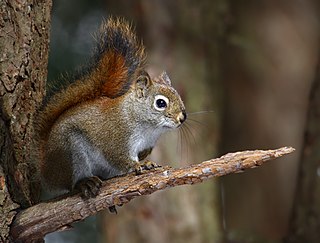
The American red squirrel is one of three species of tree squirrels currently classified in the genus Tamiasciurus, known as the pine squirrels. The American red squirrel is variously known as the pine squirrel or piney squirrel, North American red squirrel, chickaree, or simply red squirrel. The squirrel is a small, 200–250 g (7.1–8.8 oz), diurnal mammal that defends a year-round exclusive territory. It feeds primarily on the seeds of conifer cones, and is widely distributed across much of the United States and Canada wherever conifers are common, except in the southwestern United States, where it is replaced by the formerly conspecific southwestern red squirrel, and along the Pacific coast of the United States, where its cousin the Douglas squirrel is found instead.

Abert's squirrel or the tassel-eared squirrel is a tree squirrel in the genus Sciurus native to the southern Rocky Mountains from the United States to the northern Sierra Madre Occidental of Mexico, with concentrations found in Arizona, New Mexico, and southwestern Colorado. It is closely associated with, and largely confined to, mature ponderosa pine forests. It is named in honor of the American naturalist John James Abert; nine subspecies are recognised. It is recognizable by its tufted ears, gray color, pale underparts and rufous patch on the lower back. The squirrel feeds on the seeds and cones of the Mexican pinyon and the ponderosa pine when they are available, but will also take fungi, buds, bark, and carrion. Breeding normally occurs in summer, with a spherical nest being built high in the canopy.

Merlin Devere Tuttle is an American ecologist, conservationist, writer and wildlife photographer who has specialized in bat ecology, behavior, and conservation. He is credited with protecting the Austin Congress Avenue Bridge bat colony from extermination. Tuttle is currently active as founder and executive director of Merlin Tuttle's Bat Conservation (MTBC) in Austin, Texas.

The Bolivian squirrel is a tree squirrel that is endemic to South America. Little is known of the species, which may represent a species complex.

Bangs's mountain squirrel is a poorly known species of tree squirrel, that only lives in Costa Rica and Panama. It can be found in mountain rain forests at an altitude between 1,900 and 2,600 metres, and lives mainly in the tree tops, but sometimes on the forest floor as well. One of its habitats is at the summit of the Poás Volcano in Costa Rica, in a Clusia forest that is almost inaccessible to humans.
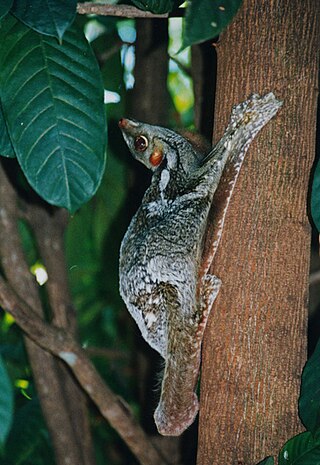
The Sunda flying lemur, also known as Sunda colugo, Malayan flying lemur and Malayan colugo, is native to Southeast Asia ranging from southern Myanmar, Thailand, southern Vietnam, Malaysia to Singapore and Indonesia.
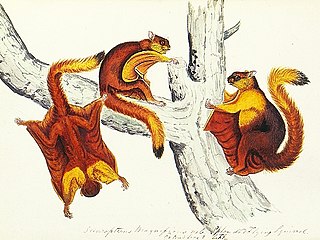
Hodgson's giant flying squirrel is a species of rodent in the family Sciuridae. This large flying squirrel lives in Himalayan forests in Asia. Like other flying squirrels, it is nocturnal and able to glide long distances between trees by spreading out its patagium, skin between its limbs.

The Bhutan giant flying squirrel, also known as the Gray's giant flying squirrel or noble giant flying squirrel, is a species of rodent in the family Sciuridae. This species lives in Himalayan forests and it is one of the largest flying squirrels. Like other flying squirrels, it is mainly nocturnal and able to glide long distances between trees by spreading out its patagium, skin between its limbs.
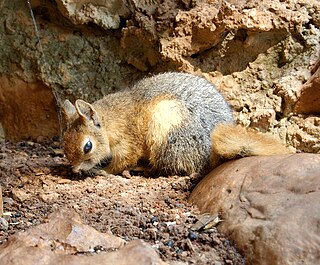
The Caucasian squirrel or Persian squirrel, is a tree squirrel in the genus Sciurus found in temperate broadleaf and mixed forests in south-western Asia.

The Arizona gray squirrel is a tree squirrel, in the genus Sciurus, endemic to the canyons and valleys surrounded by deciduous and mixed forests in eastern Arizona and northern Mexico.
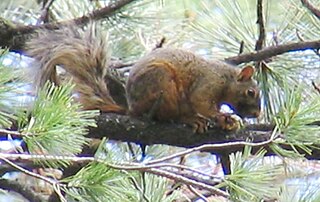
The Mexican fox squirrel is a species of tree squirrel found throughout the Sierra Madre Occidental of Mexico as far south as Jalisco — and northward into the Chiricahua Mountains of southeastern Arizona, U.S.

Mearns's squirrel is a subspecies of the Douglas squirrel endemic to Mexico. It is endangered and occurs in low densities, and is threatened by habitat loss. It is possibly also threatened by competition from the eastern gray squirrel, which was introduced to the range of Mearns's squirrel in 1946, but may not be present anymore. It is closely related to other subspecies of the Douglas squirrel, but far less is known about its behavior, which was first studied in detail in 2004. It is named for the 19th-century American naturalist Edgar Mearns.



















